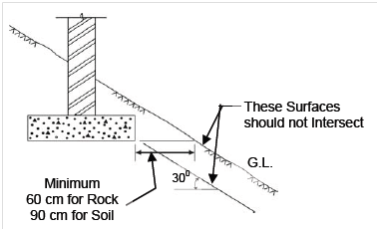Depth Of Foundation
The depth to that foundation should be taken depends on the subsequent principal factors:
(1) Securing of adequate permitted bearing capacity,
(2) In the case of clayey soils, penetration within the soil has to be below the zone where shrinkage and swelling because of seasonal weather changes and because of trees and shrubs are likely to cause appreciable movements,
(3) In fine sands and silts penetration has to be below the zone, in that trouble might be expected from frost,
(4) The maximum depth of scour while relevant (say, in bridge piers) should also be considered and the foundation should be located satisfactorily below this depth, and
(5) It should be below a top soil, tree roots, miscellaneous fill, etc.
All foundations should be taken down to a minimum depth of 0.5 m below natural ground level. In filled-up ground it might be essential to go beyond the depth of fill or take special precautions. In like cases, it might be essential for economic considerations to have the foundation at a higher level, and get the difference in level among the base of foundation and the level of excavation filled up with either:
(a) Concrete of allowable compressive strength not less than the allowable bearing pressure on the soil, or
(b) Incompressible fill material, for instance sand, gravel etc. in that case the width of fill should be more than the width of foundation for dispersion of load on either side of the base of foundation.
In sloping grounds, the horizontal distance from the bottom edge of the footing to the ground surface should be at least 60 cm for rock or 90 cm for soil. A line drawn at an angle of 30o to the base from the outer edge should not intersect the sloping surface (Figure 1).

Figure 1: Footings on Sloping Ground